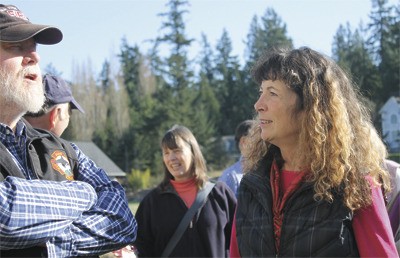The amount of acreage in the newly created San Juan Islands national monument totals just about 1,000.
But that number itself does little justice to the character or landscape of the monument–the only one in Washington state, by the way.
That’s because the monument is comprised of no fewer than 31 small islands and 40 different groups of rocks and reefs, some of which nearly disappear at high tide. It stretches from the northernmost corner of San Juan County (Patos Island) to one of the southernmost (Iceberg Point), as well as from its westernmost (Turn Point) to beyond the county’s eastern border to include low-lying rocky features and the tip of several islands in Whatcom and Skagit counties.
More than half of the land mass of the monument is concentrated in three distinct areas; 400 acres at the southend of Lopez Island, 80 acres at Kellet Bluff on Henry Island and 80 acres at Turn Point on Stuart Island. The rest is scattered all across the archipelago.
So, how does one go about managing and keeping track of such an extended and far-flung enterprise?
In a word, it’s “partnerships,” or so says Marcia deChadenedes, the monument’s newly appointed manager and veteran administrator with the Bureau of Land Management. She notes that a long-standing partnership with Washington State Parks and with Keepers of the Patos Light, a grass-roots group devoted to maintaining the islands’ historic lighthouse, have proven instrumental in helping BLM manage and maintain the 207-acre Patos Island.
At a meet-and-greet in Friday Harbor, hosted March 12 by the San Juan Preservation Trust, deChadenedes said that forging partnerships with other like-minded public agencies, federal, state and local, and with private organizations (like the Preservation Trust) and various citizen groups offers an effective route for the BLM to maximize its limited resources, balance the sometimes competing interests of recreation and conservation, and for keeping the monument’s natural and cultural resources intact.
It’s proven a successful formula for other conservation-oriented agencies as well. The San Juan County Land Bank benefits from its affiliation with the Terrestrial Managers Working Group, Land Bank Director Lincoln Bormann said. The group, whose roster includes the Nature Conservancy, Preservation Trust, county Parks, and state and federal parks, work together to find common ground and cooperative approaches to issues involving management, recreation and resource protection, Bormann said.
In addition, Bormann notes the Land Bank’s roster of volunteers, the enthusiasts of its open spaces and the neighbors of its preserves help the agency stay aware about what’s happening on its many easements, properties and preserves.
“That kind of volunteer base here is very strong,” he said, “and (the BLM) really is dependent on the same thing.”
Established by presidential proclamation about a year ago, under the Antiquities Act, the monument was created to protect and maintain the historical and cultural significance of the BLM lands in the San Juan Islands and to enhance their unique and varied natural and scientific resources.
The first step in cementing partnerships is to put together a Resource Advisory Committee, deChadenedes said. The committee will help in development of a management plan and the BLM is looking for nominees in the following categories: recreation and tourism, wildlife and ecological interests, cultural and heritage interests, tribal interests, local government, education and interpretative interests, private landowners and the public at large. Deadline for nominations is March 22.
“The potential of people on that board is profound,” she said. “It’s an opportunity that only comes along every 20 years and I’m so looking forward to hear those voices and what they have to say.”
Though well-traveled during her tenure with the BLM, deChadenedes is no stranger to the Pacific Northwest or to the San Juans. She went to school in Vancouver, B.C., fished commercially in Alaska, and spent a good deal of time in Port Townsend before beginning a career with the federal government. Her aunt, the late Edie deChadenedes, was a San Juan Island resident for about 30 years before she recently passed away.
A museums specialist with a Master’s degree from the University of Oregon, deChadenedes is also a folklorist, a vocation in which one helps a community to identify its values and what’s important to it, and then strives to make sure “the infrastructure is there to preserve it.” During her 11 years in the BLM managerial ranks, she has been involved in helping to establish the California Coastal National Monument, the Continental Divide National Scenic Trail, Heritage Tourism in New Mexico and the Camino Real International Heritage Center.
The success of all those assignments depended on building partnerships, and deChadenedes has a good guess as to why she was selected to manage the San Juan Islands monument.
“I know how to make a space where people are comfortable working together,” she said.




